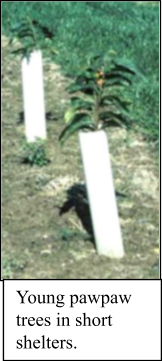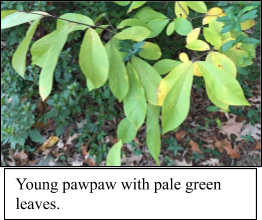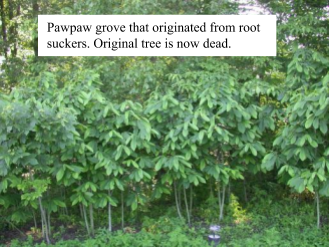Site Selection
Paw paws prefer rich, well-drained soil between 5.5 and 6.5 in pH. They also need protection from strong winds, such as in the lee side of a windbreak or building. Paw paws will bear the greatest amount of fruit if they are grown in full sun, but they can grow and bear fruit in shady sites. Paw paws are not self-fruitful, so you need two or more trees to get any fruit.

Shelter for Young Trees
When paw paws are small – under 2’ tall – they need partial shade. The very best way to accomplish this is to grow them inside a short tree shelter. The shelter gives them exactly the right amount of shade, as well as protection from wind, rabbits, deer, mowers, and clumsy feet. By the time the tree grows out the top, it no longer needs the shade. A 5’ tall tree shelter can be cut into three, 20 inch shelters for pawpaws. You can also purchase 2 foot tall shelters from Plantra.com.
Weed Control
Paw paws do not compete against weeds very well, except on shady sites. You should protect your paw paws against weed competition. Weed control is very important. The cheapest, easiest way to achieve this is with chemicals such as Oust. Chemicals should only be applied by a professional – preferably by a consulting forester. Your local NRCS office can supply you with names if you need them. Another weed control possibility is to use a 3 foot square of landscape fabric topped with 2” layer of coarse wood chips. Use eight 6” turf staples to secure corners and edges of the fabric.

Acidifying Soil
Pale green, or even yellowish leaves may be a symptom of soil with too high a pH. To acidify your soil, add elemental sulfur fertilizer. Note: pawpaw leaves normally turn yellow in the fall.
Delaying Fruiting
Your paw paws may start to produce flower buds before they reach 5’ to 6’ tall. If they do, it would be better to pinch off the flower buds and not let them set fruit. Once they start bearing fruit, the growth rate of paw paws slows down dramatically. A 3’ or 4’ paw paw tree would only bear one or two fruits per year, and stay that size for many years if you let it bear. A 5’ or 6’ pawpaw may only take another year or two to reach the bigger size, then bear 5 to 10 gallons of fruit per year!

Grafted versus Seedling Pawpaws
Grafted pawpaws have a relatively short lifespan for a tree – average maybe 15 years. Once it dies, any sprouts from the root system will be identical to the rootstock, not the grafted tree. Trees growing up from the rootstock may produce small, poor-quality fruit unless you graft it to a better variety. In contrast, seedlings from a cross between two superior varieties have a high probability of growing into superior trees themselves. Their original trunks will still die in 15 years, but when they send up suckers from the root system, those suckers will grow into trees identical to the original superior seedling—and that root system may last centuries. This is something to consider when deciding whether to go with grafted trees or seedlings.
By:
Tom Wahl & Kathy Dice
Red Fern Farm
13882 I Ave.
Wapello, IA 52653
www.redfernfarm.com
319/729-5905
tom@redfernfarm.com or kathy@redfernfarm.com
